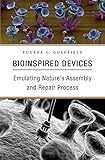Bioinspired devices : emulating nature's assembly and repair process / Eugene C. Goldfield.
Material type: TextPublication details: Cambridge, Massachusetts : Harvard University Press, 2018Description: xvi, 459 p. : ill. ; 25 cmISBN: 9780674967946 (pbk.)Subject(s): Biomedical engineering | Biomimicry | Medical innovationsDDC classification: 610.28 LOC classification: R856 | .G66 2018Summary: A goal of clinicians is to restore the body and brain function of an individual who has suffered injury and loses capabilities such as walking, using the hands, speaking, remembering, and planning ahead. There is great optimism within the clinical community that we may be able to use scientific principles and new technologies to restore lost function in these individuals. A goal of this book is to integrate advances in neuroscience, integrative biology, biomechanics, developmental science, computer science, and engineering to bring us closer to the vision of devices that harness neuroplasticity for restoring lost function. The book presents a bio-inspired approach to developing such devices. A bio-inspired device is a system whose design and manufacture are based upon the principles by which living systems build. The sources of inspiration for this new generation of devices include how cells form functional systems and organs, how systems maintain stability despite a constant turnover of materials, how system components may participate in different functions, and how biological systems evolve, develop, and learn.--
TextPublication details: Cambridge, Massachusetts : Harvard University Press, 2018Description: xvi, 459 p. : ill. ; 25 cmISBN: 9780674967946 (pbk.)Subject(s): Biomedical engineering | Biomimicry | Medical innovationsDDC classification: 610.28 LOC classification: R856 | .G66 2018Summary: A goal of clinicians is to restore the body and brain function of an individual who has suffered injury and loses capabilities such as walking, using the hands, speaking, remembering, and planning ahead. There is great optimism within the clinical community that we may be able to use scientific principles and new technologies to restore lost function in these individuals. A goal of this book is to integrate advances in neuroscience, integrative biology, biomechanics, developmental science, computer science, and engineering to bring us closer to the vision of devices that harness neuroplasticity for restoring lost function. The book presents a bio-inspired approach to developing such devices. A bio-inspired device is a system whose design and manufacture are based upon the principles by which living systems build. The sources of inspiration for this new generation of devices include how cells form functional systems and organs, how systems maintain stability despite a constant turnover of materials, how system components may participate in different functions, and how biological systems evolve, develop, and learn.--
| Item type | Current library | Collection | Call number | Copy number | Status | Date due | Barcode |
|---|---|---|---|---|---|---|---|
 General Circulation
General Circulation
|
APU Library Open Shelf | Book | R856 .G66 2018 c.1 (Browse shelf (Opens below)) | 1 | Available | 00012178 |
Includes bibliographical references and index.
A goal of clinicians is to restore the body and brain function of an individual who has suffered injury and loses capabilities such as walking, using the hands, speaking, remembering, and planning ahead. There is great optimism within the clinical community that we may be able to use scientific principles and new technologies to restore lost function in these individuals. A goal of this book is to integrate advances in neuroscience, integrative biology, biomechanics, developmental science, computer science, and engineering to bring us closer to the vision of devices that harness neuroplasticity for restoring lost function. The book presents a bio-inspired approach to developing such devices. A bio-inspired device is a system whose design and manufacture are based upon the principles by which living systems build. The sources of inspiration for this new generation of devices include how cells form functional systems and organs, how systems maintain stability despite a constant turnover of materials, how system components may participate in different functions, and how biological systems evolve, develop, and learn.--


There are no comments on this title.